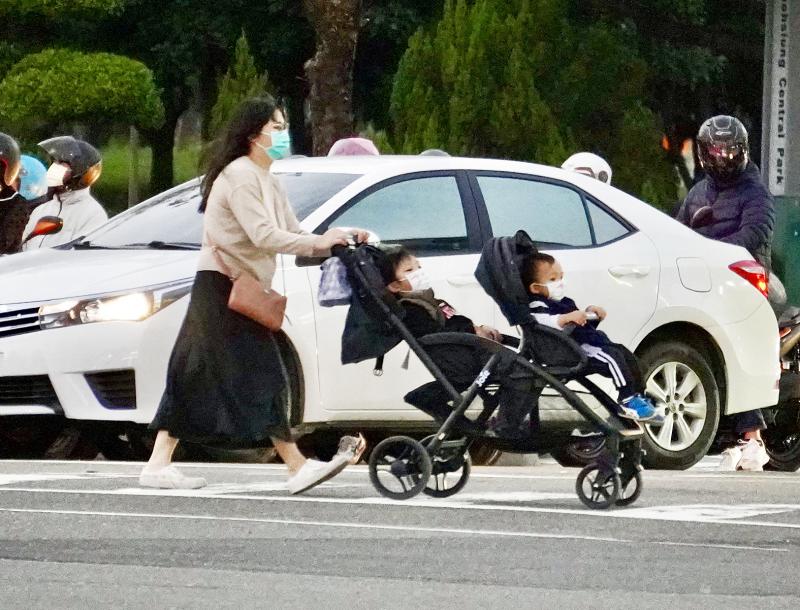The nation’s population last year dropped by an average of 509 people per day amid a record low number of births, with estimates predicting that the population might dip below 15 million in 50 years.
The population last year dropped by 185,922 from 2020 to 23.38 million, data released on Monday by the Ministry of the Interior (MOI) showed.
Only 153,820 births were recorded in the entire year, setting a record low and dipping below the death rate each month.

Photo: CNA
Last month, there were only 14,127 births, 19.5 percent fewer than the number recorded a year earlier.
Although the COVID-19 pandemic, economic fears and auspicious timing were expected to affect births, the figure is even lower than forecast, a National Development Council official said.
“The numbers are not optimistic,” the official added.
If the trend continues, the nation would be looking at the lower end of its population projection, the official said.
According to the most pessimistic of the council’s biannual projections released in August 2020, the population would only total 14.49 million by 2070.
This would spell trouble for the nation’s care burden, as the dependency ratio would climb to 102 percent from about 41 percent last year, meaning there would be one dependent for every working-age adult.
In an interview last year, National Taiwan University sociology professor James Hsueh (薛承泰) said that comparing population data from 2000 with estimates for 2040 shows a starkly different composition.
Although the population is about 22 million for both years, by 2040, the nation would be facing the dual challenge of a population that is both aging and shrinking, Hsueh said.
The COVID-19 pandemic has also dealt a blow to population numbers, with 2020 seeing the first decline since 2003, as those who have not returned to the country in two years are automatically labeled as having moved abroad.
However, the ministry advised that losing residency is not the same as losing citizenship, and it expects an increase in returnees once the pandemic eases.
Experts are also not optimistic about the birthrate this year, considering that the Year of the Tiger is an inauspicious year for births and marriage registrations last year also hit a new low of 114,606.
The birthrate would remain stable, Hsueh said, but due to the declining overall population, the total number of births would also decline.
The CIA in its World Factbook placed Taiwan at the tail end of its estimated fertility rate for last year at only 1.07 births per childbearing person, coming in just behind four other Asian countries or regions among a total of 227.
Additional reporting by Aaron Tu

Trips for more than 100,000 international and domestic air travelers could be disrupted as China launches a military exercise around Taiwan today, Taiwan’s Civil Aviation Administration (CAA) said yesterday. The exercise could affect nearly 900 flights scheduled to enter the Taipei Flight Information Region (FIR) during the exercise window, it added. A notice issued by the Chinese Civil Aviation Administration showed there would be seven temporary zones around the Taiwan Strait which would be used for live-fire exercises, lasting from 8am to 6pm today. All aircraft are prohibited from entering during exercise, it says. Taipei FIR has 14 international air routes and

Taiwan lacks effective and cost-efficient armaments to intercept rockets, making the planned “T-Dome” interception system necessary, two experts said on Tuesday. The concerns were raised after China’s military fired two waves of rockets during live-fire drills around Taiwan on Tuesday, part of two-day exercises code-named “Justice Mission 2025.” The first wave involved 17 rockets launched at 9am from Pingtan in China’s Fujian Province, according to Lieutenant General Hsieh Jih-sheng (謝日升) of the Office of the Deputy Chief of the General Staff for Intelligence at the Ministry of National Defense. Those rockets landed 70 nautical miles (129.6km) northeast of Keelung without flying over Taiwan,

The Ministry of National Defense (MND) today released images of the military tracking China’s People's Liberation Army (PLA) movements during the latest round of Chinese drills around Taiwan. The PLA began "Justice Mission 2025" drills today, carrying out live-fire drills, simulated strikes on land and maritime targets, and exercises to blockade the nation's main ports. The exercises are to continue tomorrow, with the PLA announcing sea and air space restrictions for five zones around Taiwan for 10 hours starting from 8:30am. The ministry today released images showing a Chinese J-16 fighter jet tracked by a F-16V Block 20 jet and the

City buses in Taipei and New Taipei City, as well as the Taipei MRT, would on Saturday begin accepting QR code payments from five electronic payment providers, the Taipei Department of Transportation said yesterday. The new option would allow passengers to use the “transportation QR code” feature from EasyWallet, iPass Money, iCash Pay, Jkopay or PXPay Plus. Passengers should open their preferred electronic payment app, select the “transportation code” — not the regular payment code — unlock it, and scan the code at ticket readers or gates, General Planning Division Director-General Liu Kuo-chu (劉國著) said. People should move through the